Manchester Arena bombing: Emergency services timeline
 PA
PAMonday 22 May, 2017
22:31 British Transport Police (BTP) at Victoria station hear the explosion
Both the station and the arena are owned by Network Rail, meaning the transport police have primary responsibility for both locations. Four BTP officers are already directly assigned to the Ariana Grande concert. They are at the foyer of the arena within 30 seconds.
At the same time, other officers working nearby run towards the scene. They believe they have heard a train crash.
Within 10 minutes, 19 BTP officers are at the arena's foyer.
They, arena staff and members of the public begin to provide first aid to the injured.
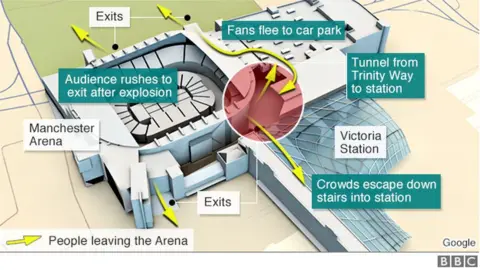
22:33 The first call is made to Greater Manchester Police reporting an explosion at the arena
A log is created and sent to the Force Duty Officer who is not initially clear as to the type of incident occurring, but alerts Armed Response Vehicles to make their way towards the arena.
22:39 A major incident is declared from the scene
Realising the severity of one young casualty's injuries, officers decide to take her straight to hospital themselves before paramedics arrive.
22:42 First paramedic arrives at Victoria station
The North West Ambulance Service (NWAS) arrives, and the management of injured people is passed to them.
BTP officers say the "sheer scale" of the challenge mean they are faced with "confusion and distress" all around the station and arena, with "devastation" in the foyer.
They are also worried about the possibility of a second explosive device, or a further attack, making members of the public and emergency responders vulnerable.
 Getty Images
Getty Images22:43 First armed police arrive in the foyer
Greater Manchester Police (GMP) arrive, and control of the scene is handed over from BTP to GMP.
Six Armed Response Vehicles, containing twelve Authorised Firearms Officers, arrive. There is an initial belief injuries may be gunshot wounds and that a "Paris style" attack could be in progress, involving a terrorist.
The Force Duty Officer has to decide whether to withdraw all responders from the foyer, as is laid down within Marauding Terrorist Firearms Attack protocols. He decides that to tell these responders to evacuate would be "unconscionable". The responders remain.
Explosive-sensing search dogs are deployed.
Paramedics start to triage the casualties, and police, arena staff and members of the public use improvised stretchers - display boards and metal crowd barriers - to carry the injured to the railway station concourse where a casualty assessment unit is set up.
The ambulance service and Medical Incident Commander assess and treat some casualties and direct them to the most appropriate hospital for their specific injuries.
22:46 Road closures start nearby
 Getty Images
Getty Images22:47 The Force Control Room receives confirmation an explosion has occurred
Within one hour of the initial call, 106 firearms officers are deploying to the Greater Manchester area to provide direct assistance to GMP.
Some of those officers drop their personal trauma packs in the foyer so that others can use them.
22:49 Twelve ambulances are at the scene
22:58 The injured are moved from the foyer to the station concourse
Once the casualties are all evacuated, the priority becomes to secure the foyer as a crime scene. The inspector hands over to the GMP Crime Scene Manager.
(No further updates for Monday)
Tuesday 23 May
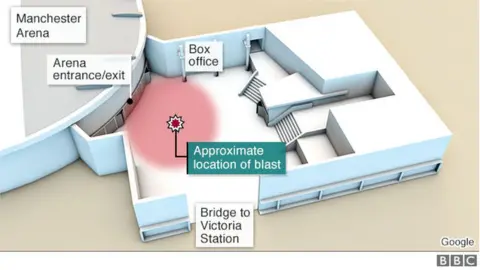
00:37 The first three fire engines arrive at the scene
02:30 A reception centre is opened by Manchester City Council at the Etihad Stadium
Thirty members of staff from the council's Children's and Adult's Social Care services are in attendance to help those affected.
Up to 14 families - some 150 people - go to the centre and after being told information would be provided to them there. The British Red Cross psychosocial team provides support.
Bereavement nurses and counsellors are also called in.
02:46 All injured transported from scene
Paramedics treat many walking wounded in the city centre. Hospitals in Greater Manchester treat people with serious injuries, transported by the ambulance service. Others make their way to hospitals across the wider region. A total of 43 hospitals (19 in the North West area and 24 others beyond) are involved.
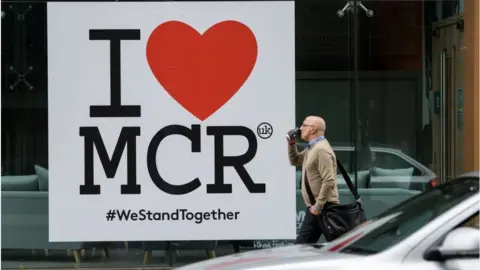 Getty Images
Getty Images15:35 First victim's body moved to temporary body storage facility on site
18:00 Vigil in front of Manchester Town Hall
The vigil is attended by thousands of people covering the wide range of ethnicity and religious groups which make up Manchester. Attendees hold banners and placards proclaiming "Love not Hate" and "We stand together". The Bishop of Manchester speaks for all faiths and poet Tony Walsh performs his poem about the city, This is the Place.
20:10 First body transported to mortuary
Each victim is taken individually to the designated mortuary in a private ambulance, with a police escort front and back, at a funereal pace as a mark of respect. Exactly the same transport arrangements are used to convey the deceased victims from the hospitals to which they had been taken immediately after the attack.
The body of the attacker is removed and immediately transported in a completely separate vehicle, to another coroner's jurisdiction - outside of Greater Manchester - for forensic and post-mortem examination. This is completed first to support the needs of the counter-terrorism investigation.
21:07 Last body removed to temporary facility on site
The scene of the attack is secured and all living casualties are evacuated. Arrangements are made for the recovery of the deceased victims from the scene to the mortuary.
The bodies of the deceased victims are recovered one by one.
There are substantial health and safety risks to the recovery process, including the unstable condition of the glass ceiling damaged in the blast with the potential to drop large shards of glass into the foyer below.
As each victim is examined at the scene, details of their personal belongings and clothing are communicated to the Senior Identification Manager, enabling each family in turn to be informed of the findings.
In those conversations with families, the coroner, bereavement nurses and police officers seek to make it clear that whilst it would be some time before an official identification would be made through the Identification Commission process, all the indications are that their loved one is among the deceased.
Wednesday 24 May
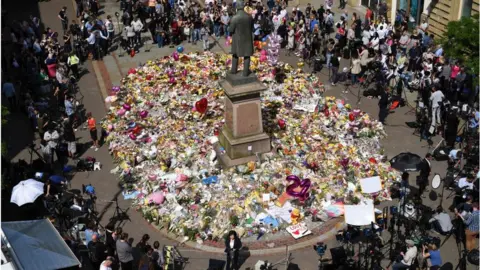 Getty Images
Getty Images03:20 Final victim's body transported to mortuary (with police escort front and back)
Later, the families of those who died are given a box containing their loved one's clothes, which have been professionally laundered and packed between leaves of tissue paper.
Thursday 25 May
18:00 National two-minute silence marked by mass attendance at vigil in St. Ann's Square
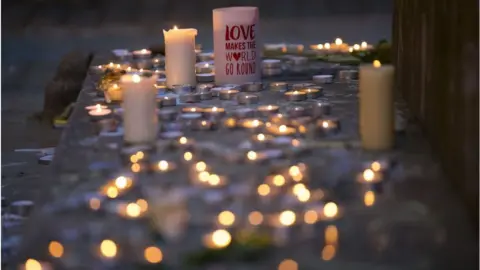 Getty Images
Getty ImagesAbout 4,000 people gather to mark the silence.
In the time between the two vigils, the council has organised the movement of the flowers and other tributes that had been placed in Albert Square in front of the town hall. Council volunteers move each tribute by hand.
Thursday 8 June
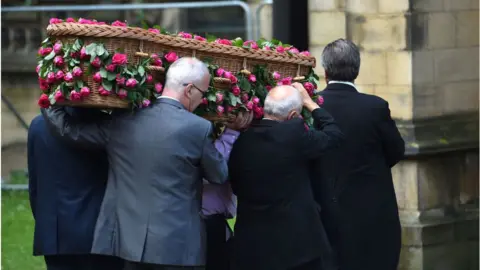 Getty Images
Getty ImagesAll the deceased victims are formally identified to the standards specified by the coroner and are authorised for release to their families by 8 June 2017. All of those involved in the mortuary processes work every day without a break until that is achieved - in order that the families receive their loved ones back at the earliest opportunity.
